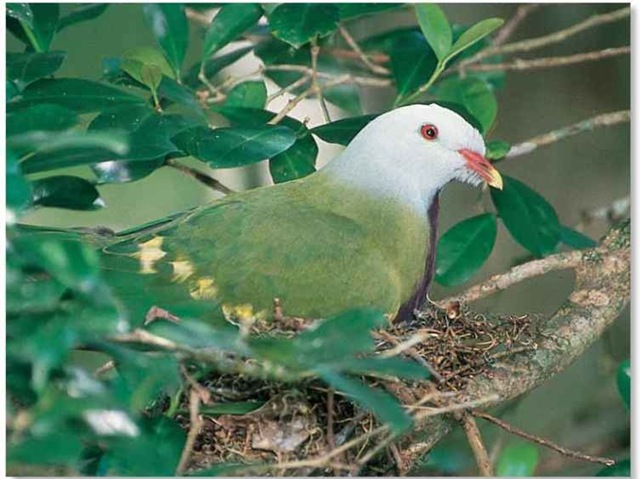ORDER
Columbiformes
FAMILY
Columbidae
GENUS & SPECIES
key features
Fruit-eating dove that has adapted to most forest environments throughout its range Also known as the magnificent fruit dove, due to its colorful plumage
Hangs upside down on a tree branch when foraging for hard-to-reach fruit
where in the world?
Found in Australia in
New South Wales,
Queensland and victoria; also New Guinea and adjacent islands
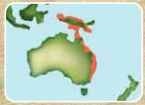
LIFECYCLE
The fruit dove nests on exposed branches in trees, finding relatively open areas in the forest; the single egg is incubated by the male during the day and the female at night.
HABITAT
The wompoo fruit dove inhabits a variety of forest types, including primary and well-developed secondary rainforest, gallery forest and monsoon forest. In New Guinea, it occurs from near sea level up to 4,500′, but is more common at lower elevations.The fruit dove is also found in New South Wales in eucalyptus forests and farmland during the winter months. This species is able to cross open country and adapt to habitat other than rainforest, such as both lowland and hill forests.
Forest home The wompoo fruit dove prefers the thick rainforests of eastern Australia.

To compensate for wear and damage caused by feather mites, the wompoo fruit dove grows new feathers each year after the breeding season.
Pigeons and doves are among the most powerful and agile fliers; their flight muscles are relatively larger than those of most other bird groups.
BEHAVIOR
In the eastern part of Australia, wompoo fruit dove populations are sedentary; others move based on the availability of ripening fruit. Despite its colorful plumage, the bird sometimes can be difficult to see when it feeds high in the trees. It makes its presence known by a wompoo call that sounds like a loud, monotonous woo note, hence its name. When the bird is feeding, it makes a low-pitched pack-pack-pack sound and a guttural bahroo noise. Flight muscles are large and powerful in these agile fliers, enabling the bird to cross large bodies of water to find food, as it flies from island to island. The bird bathes in the rain or puddles and takes dust baths. The fruit dove uses its bill to remove foreign bodies such as parasites and to rehook the zipperlike portions of a feather (barbicles) that have come loose on the flight feathers.
Vocal chords The wompoo fruit dove is very vocal, whether feeding or at rest.
BREEDING
The fruit dove breeds mainly from the middle of the dry season to early wet season in both Papua New Guinea and eastern Australia, with some breeding occurring year-round. These monogamous birds form pairs, defend territories and build nests. The nest is a large platform made of twigs and vines placed on a fork or palm frond, 12-20′ high. The female lays one white egg, which is incubated by both sexes for at least 21 days. If the brood-ingparent is disturbed, it usually pretends to fall from the nest, then flies clumsily away in a distraction display Both sexes prepare crop milk for their young prior to hatching. The chick stimulates the parent by placing its bill into its parent’s bill. Although the chick is ready to fledge in 13-14 days, it feeds on crop milk long after fledging; the time it reaches sexual maturity is still unknown.
EGG PROTECTION
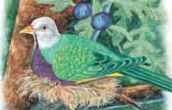
Guarding the young…
The wompoo fruit dove sits on its nest in a fork near the branch of a fig tree. Parents take turns incubating the single egg.

Danger approaches…
A New Guinea quoll clambers up the tree trunk as the wompoo fruit dove stands in front of the nest exposing its egg.
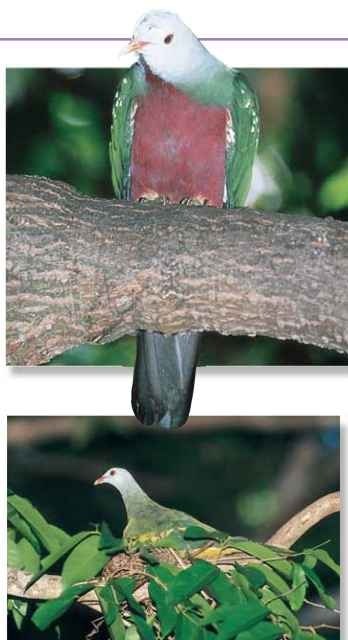
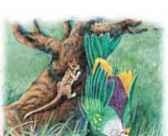
Dramatic drop…
The dove falls from the nest with wings partially folded, causing the quoll to freeze midway up the trunk and to look down at the bird.
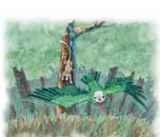
Distracted
The dove flies low and erratically through the trees in a distraction display.The quoll climbs down to pursue the dove.
CONSERVATION
The fruit dove is not globally threatened and remains widespread and common in most of its range. However, the southernmost species (Ptilinopus magnfcus magnificus) has declined severely due to habitat loss and overhunting.
FOOD & FEEDING
The dove eats a wide variety of fruits — more than 50 plant species according to one study It prefers fruit from the fig family, as well as laurels and palms. In Australia, the favored food is the fruit of white cedar. As the dove forages, it feeds at all levels of the forest from understory to the canopy, mostly in lower canopy and midlevel. It feeds singly in pairs or small flocks.The wompoo fruit dove ventures onto a branch, hanging upside down on the thinnest twigs to reach its favorite fruit. Using the hard tip of its beak, the dove plucks fruit and then swallows it whole. The gizzard walls consist of hard nodules and ridges, which rub the fleshy pulp and skin off the fruit; undigested stones pass into the intestines and are later expelled whole. This fruit-eating bird has a shorter’ nte st i n e ‘ than birds that eat only seeds. Like all doves, the fruit dove needs water to moisten and help digest its food. It sucks water up through a pumping action, rather than raising its head to swallow like other birds.
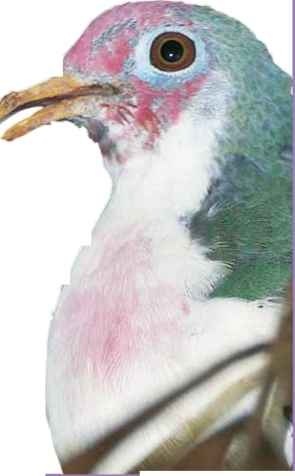
Special beak The fruit dove’s beak is adapted for eating fruits; the hard tip allows it to easily pluck its food from the trees.
PROFILE
Wompoo Fruit Dove
With its rainbow of colors, the wompoo fruit dove makes an impressive sight as it soars through the trees of the forest.
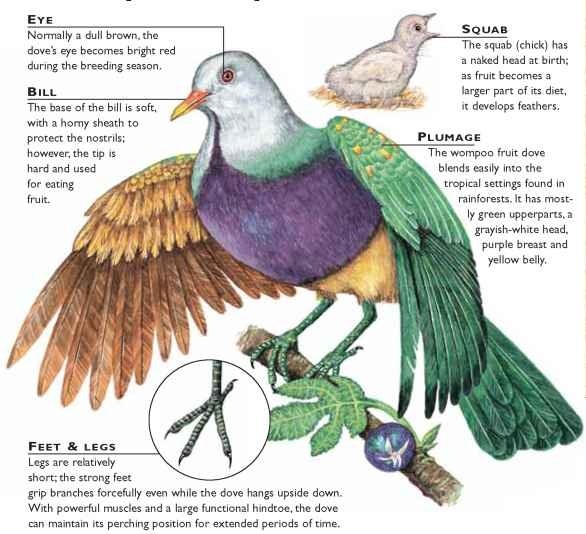
CREATURE COMPARISONS
Considerably smaller than the wompoo fruit dove, the many-colored fruit dove (Ptilinopus perousii) weighs 2.5-3 oz. and measures up to 9″.The many-colored fruit dove is pale yellowish-white above with a crimson band across the upper back, crimson forehead and crown, and a prominent breast patch with purple-pink spots; its Australian cousin is bright green with a gray head, purple throat and yellow bands on its wings. Found in Upolu, Samoa, Fiji and other adjacent islands in the Pacific Ocean, the many-colored fruit dove also eats fruit, primarily from the banyan tree, and inhabits the forest canopy.
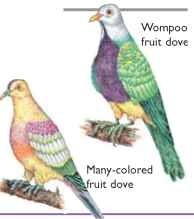
| vital statistics | |
| Weight | 8.5-17.5 oz. |
| Length | 11.5-18″ |
| Wingspan | Unknown |
| Sexual Maturity | Unknown |
| Breeding Season | Year-round |
| Number of Eggs | 1 |
| Incubation Period | At least 21 days |
| Fledging Period | About 13-14 days |
| Breeding Interval | 1 year |
| Typical [Diet | Fruits and berries |
| Unknown | |
Related species
• The wompoo fruit dove is 1 of 51 species in the genus Ptilinopus, including the pink-spotted fruit dove, P. perlatus, the ornate fruit dove, P ornatus, and the superb fruit dove, P. superbus. The family Columbidae contains 309 species in 42 genera of pigeons If, ” ‘ and doves. The order Columbiformes includes about 325 species in 2 families of sandgrouse, pigeons and doves.
